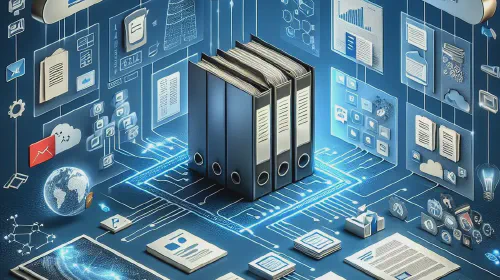The Evolution of File Management - From Traditional to Cloud-Based Systems
Salomon Kisters
Dec 28, 2023This post may contain affiliate links. If you use these links to buy something we may earn a commission. Thanks!
Welcome to the digital age, where the cloud reigns supreme in the realm of file management. Gone are the days of cumbersome physical storage and the limitations of local networks. In this blog, we embark on a journey through the world of cloud-based file management systems, a transformative force reshaping how organizations manage their precious data.
We’ll uncover the layers of this technological marvel, examining its ascendancy over traditional methods, the myriad of benefits it bestows, the hurdles encountered along the migration path, and a glimpse into the future that awaits this ever-evolving domain. So, fasten your seatbelts and prepare to elevate your understanding of the cloud and its pivotal role in modern file management.
Exploring Cloud-Based File Management Systems
Cloud-based file management systems have revolutionized the way organizations handle their data. By leveraging the power of the cloud, these systems offer a range of benefits over traditional file management methods, including improved accessibility, scalability, and collaboration.
As we delve into the intricacies of cloud-based systems, we’ll explore how they are replacing traditional methods, the benefits they provide, the challenges faced during the transition, and what the future holds for this technology.
How Cloud-Based Systems Replace Traditional Methods
Transitioning from traditional methods, cloud-based file management systems are transforming the approach to data storage and management. Traditional methods often involve on-premise storage solutions, such as file servers or document management software installed on local networks. These systems require significant upfront investment in hardware and software, as well as ongoing maintenance and support.
In contrast, cloud-based systems offer a more flexible and cost-effective solution. They allow users to store files on remote servers operated by cloud service providers, eliminating the need for physical infrastructure. This shift enables organizations to access their data from anywhere with an internet connection, using protocols like SMB or NFS.
Services like Azure Files and Egnyte have emerged as popular choices, providing network file shares in the cloud and replacing traditional file servers.
The transition to cloud-based systems often involves a “lift and shift” strategy, where applications and data are moved to the cloud without significant changes to their architecture. This approach simplifies the migration process and allows organizations to modernize their infrastructure beyond just file storage.
Benefits of Cloud-Based File Management Systems over Traditional Methods
The benefits of cloud-based file management systems are numerous and impactful. They offer greater flexibility, as data can be accessed from any internet-connected device, facilitating remote work and collaboration. Cloud-based systems are also typically more cost-effective, as they reduce the need for expensive hardware and software licenses. Additionally, they provide scalability, allowing businesses to easily adjust their storage capacity based on current needs.
Moreover, cloud-based systems streamline various processes, such as accounting and data management, by offering tools and applications like data storage, servers, databases, networking, and software as a service. This eliminates the traditional need for IT administrators to provision and manage compute resources, shifting the focus to more strategic tasks.
Challenges of Transitioning to Cloud-Based File Management Systems
Despite the advantages, transitioning to cloud-based file management systems can present challenges. Organizations must ensure a smooth transition process, which includes addressing concerns related to security, data governance, and compliance. Training employees to use new cloud-based tools and applications is also essential to maximize the benefits of the transition.
Another challenge is the potential disruption to existing workflows and the need to integrate cloud-based systems with other business services. Companies must carefully plan their cloud migration strategies to avoid service interruptions and ensure that their cloud security posture management strategies are adequate for protecting their cloud-based infrastructure.
Future of Cloud-Based File Management Systems
Looking ahead, the future of cloud-based file management systems is promising, with advancements expected in areas such as consistency, mobile access, artificial intelligence, and enhanced security. These systems are anticipated to become even more flexible and scalable. Hence, it assists organizations in managing complex workflows and handling massive datasets processed by ELT tools, ensuring efficient data movement across systems. Ultimately, it provides organizations with innovative tools and solutions that revolutionize file management.
As cloud computing continues to evolve, file management systems will likely become more intuitive, anticipating user needs and presenting relevant files based on context. The trend towards cloud-based solutions is clear, with an increasing number of businesses recognizing the benefits and moving away from traditional paper-based systems.
Updates and Interfaces in File Management Systems
Discovering New Updates in File Management Systems
File management systems are essential tools that help users organize, store, and access their digital files efficiently. Staying updated with the latest enhancements in these systems can significantly improve productivity and security. Recent updates in file management systems have focused on improving user experience, enhancing security measures, and integrating advanced features such as artificial intelligence and machine learning for better file categorization and search capabilities.
One notable trend is the modernization of Judiciary’s case management systems, which are being updated to provide more streamlined and efficient access to legal documents. Additionally, updates in file management systems often include improvements to document management, allowing for easier collaboration and communication within teams.
Users should be cautious when updating their systems, ensuring that they are downloading legitimate updates and not files disguised as updates, which could be harmful. It is also important to follow trusted sources or official alerts for the latest releases to keep file management systems up-to-date and secure.
Navigating New Interfaces in Existing Systems
With the introduction of new updates, file management systems often come with redesigned interfaces that aim to enhance user interaction and workflow. Navigating these new interfaces can be challenging for some users, especially if the changes are significant. However, understanding the basic layout and functionalities of the system can ease the transition.
To navigate new interfaces effectively, users should take advantage of tutorials, help guides, or demo modes offered by the software. These resources can provide step-by-step instructions on how to perform common tasks and manage files within the new system. For instance, learning how to request file transfers, manage directories, or customize the interface can be crucial for adapting to the new environment.
System administrators, in particular, may need to manage multiple interfaces and should familiarize themselves with the GUI (Graphical User Interface) to perform tasks efficiently. It’s also important for users to explore the interface to discover shortcuts and tools that can optimize their workflow.
When users encounter difficulties with new interfaces, they should not hesitate to reach out to customer support or community forums for assistance. Feedback on the interface is also valuable for developers to make necessary adjustments and improve the user experience.
Conclusion
As we draw the curtains on our exploration of cloud-based file management systems, it’s clear that these platforms are not just a fleeting trend but a fundamental shift in data management practices. They have set a new benchmark, offering unparalleled benefits that traditional methods struggle to match.
With the relentless march of technology, we can anticipate these systems to become even more sophisticated, intuitive, and secure, continuing to revolutionize the way organizations handle their data. The future is bright for cloud-based file management, and it’s an exciting time for businesses to embrace this change, harness its potential, and soar to new heights of efficiency and collaboration.
Stay informed with the latest insights in Crypto, Blockchain, and Cyber-Security! Subscribe to our newsletter now to receive exclusive updates, expert analyses, and current developments directly to your inbox. Don't miss the opportunity to expand your knowledge and stay up-to-date.
Love what you're reading? Subscribe for top stories in Crypto, Blockchain, and Cyber-Security. Stay informed with exclusive updates.
Please note that the Content may have been generated with the Help of AI. The editorial content of OriginStamp AG does not constitute a recommendation for investment or purchase advice. In principle, an investment can also lead to a total loss. Therefore, please seek advice before making an investment decision.

Features and Customization of Document Management Software
Discover DMS features, customization, real-world applications, and actionable steps to enhance your operations and foster innovation.

The Best Document Management Systems of the Year
Learn to choose the ideal DMS for your needs, with insights on top systems like LogicalDOC and Autodesk Docs, ensuring future success through advanced document management.

Cloud-Based Solutions for Document Management and File Sharing
Discover the key to efficient document management and file sharing with our in-depth guide on cloud-based solutions, tailored for the modern digital workplace.
Protect your documents
Your gateway to unforgeable data. Imprint the authenticity of your information with our blockchain timestamp